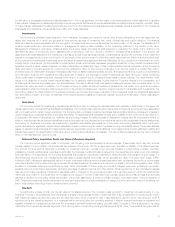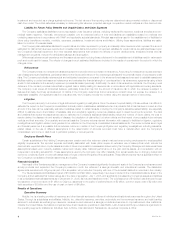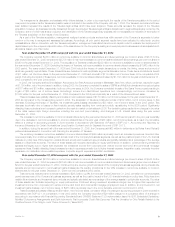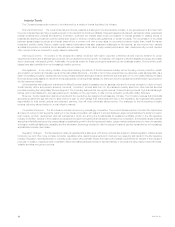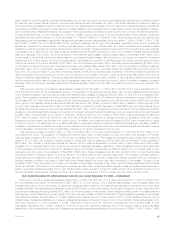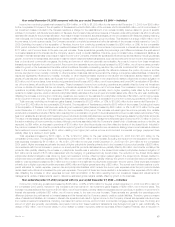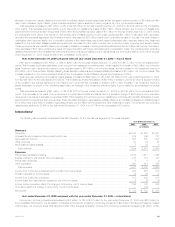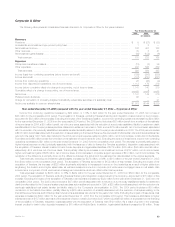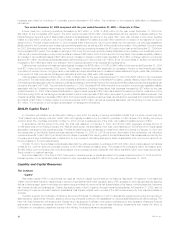MetLife 2005 Annual Report Download - page 20
Download and view the complete annual report
Please find page 20 of the 2005 MetLife annual report below. You can navigate through the pages in the report by either clicking on the pages listed below, or by using the keyword search tool below to find specific information within the annual report.Year ended December 31, 2005 compared with the year ended December 31, 2004 — Individual
Income from continuing operations increased by $344 million, or 40%, to $1,208 million for the year ended December 31, 2005 from $863 million
for the comparable 2004 period. The acquisition of Travelers accounted for $96 million of the increase which includes $66 million, net of income taxes, of
net investment losses. Included in the Travelers results is a charge for the establishment of an excess mortality reserve related to group of specific
policies. In connection with MetLife’s acquisition of Travelers, the Company has performed reviews of Travelers underwriting criteria in its effort to refine its
estimated fair values for the purchase allocation. As a result of these reviews and actuarial analyses, and to be consistent with MetLife’s existing reserving
methodologies, the Company has established an excess mortality reserve on a specific group of policies. This resulted in a charge of $20 million, net of
income taxes, to fourth quarter results. The Company expects to complete its reviews and refine its estimate of the excess mortality reserve by June 30,
2006. Excluding the impact of the acquisition of Travelers, income from continuing operations increased by $248 million, or 29%, for the comparable
2004 period. Included in this increase are net investment losses of $26 million, net of income taxes. Improvements in interest rate spreads contributed
$117 million, net of income taxes, to the year over year increase. These spreads are generally the percentage point difference between the yield earned
on invested assets and the interest rate the Company uses to credit on certain liabilities. Therefore, given a constant value of assets and liabilities, an
increase in interest rate spreads would result in higher income to the Company. Interest rate spreads are influenced by several factors, including business
growth, movement in interest rates, and certain investment and investment-related transactions, such as corporate joint venture income and prepayment
fees on bonds and commercial mortgages, the timing and amount of which are generally unpredictable. As a result, income from these investment
transactions may fluctuate from period to period. Fee income from separate account products increased by $126 million, net of income taxes, primarily
related to growth in the business and favorable market conditions. Favorable underwriting results in life products contributed $37 million, net of income
taxes, to the increase in income from continuing operations. Underwriting results are generally the difference between the portion of premium and fee
income intended to cover mortality, morbidity or other insurance costs less claims incurred and the change in insurance-related liabilities. Underwriting
results are significantly influenced by mortality, morbidity, or other insurance-related experience trends and the reinsurance activity related to certain
blocks of business and, as a result, can fluctuate from period to period. The decrease in the closed-block related policyholder dividend obligation of
$27 million, net of income taxes, lower annuity net guaranteed benefit costs of $12 million, net of income taxes, and lower DAC amortization of $6 million,
net of income taxes, all contributed to the increase. These increases in income from continuing operations are partially offset by lower net investment
income on blocks of business that are not driven by interest rate spreads of $19 million, net of income taxes. The increase in income from continuing
operations is partially offset by higher expenses of $10 million, net of income taxes, primarily due to higher operating costs offset by the impact of
revisions to certain expense, premium tax and policyholder liability estimates in the current year and certain asset write-offs in the prior year. Additionally,
offsetting the increase in income from continuing operations, is a revision to the estimate for policyholder dividends of $9 million, net of income taxes,
which occurred in the prior year. The changes in tax rates between years accounted for a decrease in income from continuing operations of $15 million.
Total revenues, excluding net investment gains (losses), increased by $1,528 million, or 12%, to $13,990 million for the year ended December 31,
2005 from $12,462 million for the comparable 2004 period. The acquisition of Travelers accounted for $975 million of the increase. Excluding the impact
of the acquisition of Travelers, total revenues, excluding net investment gains (losses) increased by $553 million, or 4%, to $13,015 million for the year
ended December 31, 2005 from $12,462 million for the comparable 2004 period. This increase includes higher fee income primarily from variable
annuity and universal life products of $239 million resulting from a combination of growth in the business and improved overall market performance. Policy
fees from variable life and annuity and investment-type products are typically calculated as a percentage of the average assets in policyholder accounts.
The value of these assets can fluctuate depending on equity performance. In addition, management attributes higher premiums of $170 million in 2005 to
the active marketing of income annuity products. Although premiums associated with the Company’s closed block of business continue to decline, as
expected, by $94 million, an increase in premiums of $130 million from other life products more than offset the decline of the closed block. Included in
the premium increase of the other life products is the impact of growth in the business and a new reinsurance strategy where more business is retained.
Net investment income increased by $108 million resulting from higher joint venture income and bond and commercial mortgage prepayment fees
partially offset by a decline in bond yields.
Total expenses increased by $876 million, or 8%, to $12,137 million for the year ended December 31, 2005 from $11,261 million for the
comparable 2004 period. The acquisition of Travelers accounted for $761 million of the increase. Excluding the impact from the acquisition of Travelers,
total expenses increased by $115 million, or 1%, to $11,376 million for the year ended December 31, 2005 from $11,261 million for the comparable
2004 period. Higher expenses are primarily the result of higher policyholder benefits primarily due to the increase in future policy benefits of $207 million,
commensurate with the net increase in premium on annuity and life products discussed above, partially offset by $5 million due to better mortality in life
products. Also partially offsetting the increase in policyholder benefits was a reduction in the closed block-related policyholder dividend obligation of
$41 million and a benefit of $18 million associated with the hedging of guaranteed annuity benefit riders. The reduction in the closed block-related
policyholder dividend obligation was driven by lower net investment income, offset by higher realized gains in the closed block. Interest credited to
policyholder account balances decreased by $45 million due to lower crediting rates, partially offset by the growth in policyholder account balances. In
addition, total expenses increased by $13 million due to a revision in the estimate of policyholder dividends in the prior period. Other expenses increased
primarily due to higher corporate incentive expenses of $60 million and higher general spending of $28 million. The current year includes revisions to prior
period estimates for certain expense, premium tax and policyholder liabilities which reduce the current year expenses while the prior period includes
certain asset write-offs which increased the prior year expenses. The impact of these two items resulted in a decrease in other expenses of $73 million.
Also offsetting the increase in other expenses is lower DAC amortization of $9 million resulting from net investment losses and adjustments for
management’s update of assumptions used to determine estimated gross margins partially offset by growth in the business.
Year ended December 31, 2004 compared with the year ended December 31, 2003 — Individual
Income from continuing operations increased by $345 million, or 66%, to $864 million for the year ended December 31, 2004 from $519 million for
the comparable 2003 period. Included in this increase is an improvement in net investment gains (losses) of $269 million, net of income taxes. This
increase includes additional fee income of $186 million, net of income taxes, primarily related to separate account products. In addition, improvement in
interest rate spreads contributed $81 million, net of income taxes, to the year over year increase. These spreads are generally the percentage point
difference between the yield earned on invested assets and the interest rate the Company uses to credit on certain liabilities. Therefore, given a constant
value of assets and liabilities, an increase in interest rate spreads would result in higher income to the Company. Interest rate spreads include income
from certain investment transactions, including corporate joint venture income and bond and commercial mortgage prepayment fees, the timing and
amount of which are generally unpredictable. As a result, income from these investment transactions may fluctuate from year to year. Additionally, the
charge of $32 million, net of income taxes, in 2003 related to certain improperly deferred expenses at New England Financial, and a reduction in
MetLife, Inc. 17


